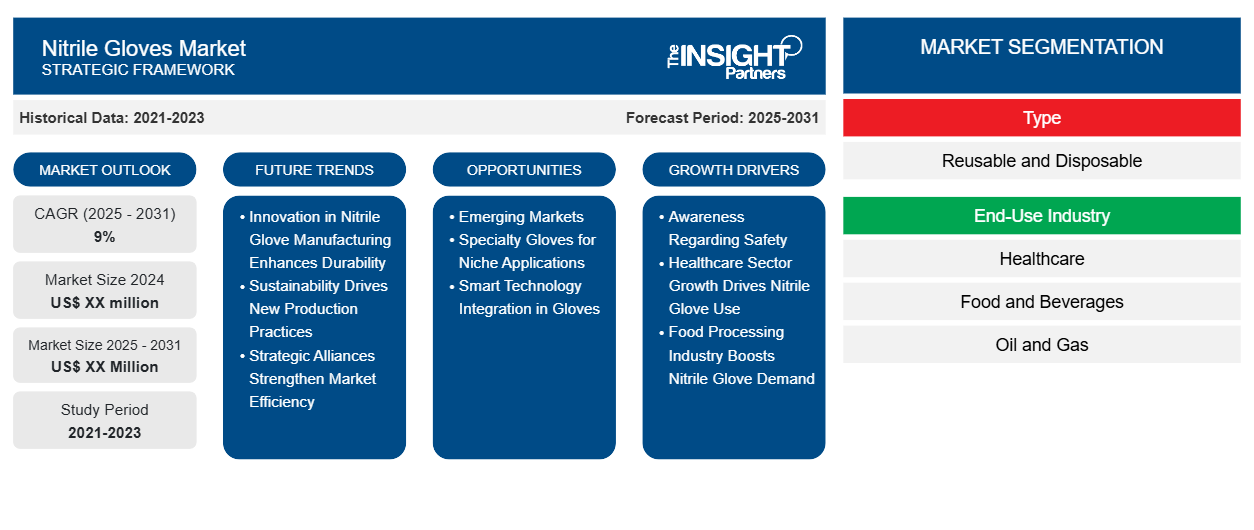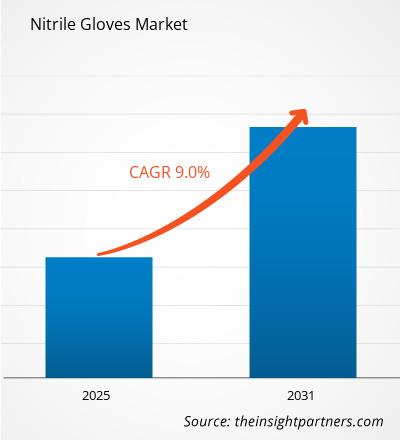The Nitrile Gloves Market is expected to register a CAGR of 9% from 2025 to 2031, with a market size expanding from US$ XX million in 2024 to US$ XX Million by 2031.
The report is segmented by type (reusable and disposable). The report further presents analysis based on end-use industry (healthcare, food and beverages, oil and gas, chemicals, automotive, pharmaceuticals and others). The global analysis is further broken-down at regional level and major countries. The market size and forecast at global, regional, and country levels for all the key market segments are covered under the scope. The report offers the value in USD for the above analysis and segments. The report provides key statistics on the market status of the key market players and offers market trends and opportunities.
Purpose of the Report
The report Nitrile Gloves Market by The Insight Partners aims to describe the present landscape and future growth, top driving factors, challenges, and opportunities. This will provide insights to various business stakeholders, such as:
- Technology Providers/Manufacturers: To understand the evolving market dynamics and know the potential growth opportunities, enabling them to make informed strategic decisions.
- Investors: To conduct a comprehensive trend analysis regarding the market growth rate, market financial projections, and opportunities that exist across the value chain.
- Regulatory bodies: To regulate policies and police activities in the market with the aim of minimizing abuse, preserving investor trust and confidence, and upholding the integrity and stability of the market.
Nitrile Gloves Market Segmentation
Type
- Reusable and Disposable
End-Use Industry
- Healthcare
- Food and Beverages
- Oil and Gas
- Chemicals
- Automotive
- Pharmaceuticals and Others
You will get customization on any report - free of charge - including parts of this report, or country-level analysis, Excel Data pack, as well as avail great offers and discounts for start-ups & universities
Nitrile Gloves Market: Strategic Insights

-
Get Top Key Market Trends of this report.This FREE sample will include data analysis, ranging from market trends to estimates and forecasts.
Nitrile Gloves Market Growth Drivers
- Awareness Regarding Safety: Different industries, especially health care and food services, have undertaken stringent health and safety measures due to the COVID-19 global outbreak. As a result, the need for personal protective equipment (PPE) such as nitrile gloves increased because entities wanted to shield their staff and customers from possible exposure. Even though the outbreak will be under control, the trends in the safe new practices will likely keep the demand for nitrile gloves since most businesses will still exercise health policies.
- Healthcare Sector Growth Drives Nitrile Glove Use: In the healthcare sector, nitrile gloves are used highly, driven by the growing number of medical interventions and the need for proper infection control. Since the population is aging, the burden of chronic diseases is increasing, hence the demand for health care services is anticipated to rise. Thus, this situation will cause continued growth in the use of nitrile gloves within hospitals, clinics, and labs, further enhancing the market growth.
- Food Processing Industry Boosts Nitrile Glove Demand: The food processing services sector is also essential in increasing the demand for nitrile gloves. Food operators follow safety standards to avoid contamination, complying with stringent food safety and hygiene regulations. Nitrile gloves within this industry are known to be more effective due to their puncture-proof nature and good gripping ability. Further growth of the food service sector supports the provision of take-out and delivery services, increasing the use of nitrile gloves.
Nitrile Gloves Market Future Trends
- Innovation in Nitrile Glove Manufacturing Enhances Durability: Owing to the recent growth in manufacturing technologies, more advanced nitrile gloves have been created. Developing new polymer compositions and sophisticated gear contributes to their extended durability, tactility, and comfort. Companies also focus on innovations and developing gloves with improved characteristics, such as chemical resistance specific to certain industries or for better fitting, comfortable wear in medical applications.
- Sustainability Drives New Production Practices: The increase in sustainability measures is also evident in the nitrile gloves market. The major manufacturers are paying more attention to the environmentally friendly production process and materials. This includes producing nitrile gloves that quickly decompose when disposed of and using reclaimed nitrile in glove manufacture. It is expected that as the general population and businesses become more aware of the environment, they will want more sustainable products, resulting in a shift in the practices of the manufacturers.
- Strategic Alliances Strengthen Market Efficiency: The nitrile gloves market has also witnessed a rise in strategic alliances between manufacturers, distributors, and healthcare providers. A growing number of collaborations of this kind aim at increasing the efficiency of supply chains, making the products more accessible to customers, and achieving new product development. In this way, the parties functional to the market can more effectively satisfy the market need and ensure the supply of nitryl gloves even during increased consumption.
Nitrile Gloves Market Opportunities
- Emerging Markets: Emerging markets, particularly in Asia-Pacific, Latin America, and Africa, present significant growth opportunities for the nitrile gloves market. As these regions experience economic growth and increased investment in healthcare infrastructure, the demand for nitrile gloves is expected to rise. Companies can capitalize on this trend by establishing local manufacturing facilities and distribution networks to cater to the growing demand in these markets.
- Specialty Gloves for Niche Applications: There is considerable potential for innovation in the development of specialty nitrile gloves tailored for specific applications. For instance, gloves designed for high-risk environments, such as chemical handling or surgical procedures, can be developed with enhanced protective features. By creating specialized products that meet the unique needs of various industries, manufacturers can tap into new market segments and enhance their product offerings.
- Smart Technology Integration in Gloves: Integrating smart technologies into nitrile gloves presents an exciting opportunity for the market. For example, gloves with sensors that monitor hand hygiene or detect chemical exposure could provide added safety for users in healthcare and industrial settings. By leveraging technological advancements, manufacturers can create innovative products that enhance user safety and improve compliance with health regulations.
Nitrile Gloves Market Regional Insights
The regional trends and factors influencing the Nitrile Gloves Market throughout the forecast period have been thoroughly explained by the analysts at The Insight Partners. This section also discusses Nitrile Gloves Market segments and geography across North America, Europe, Asia Pacific, Middle East and Africa, and South and Central America.
Nitrile Gloves Market Report Scope
| Report Attribute | Details |
|---|---|
| Market size in 2024 | US$ XX million |
| Market Size by 2031 | US$ XX Million |
| Global CAGR (2025 - 2031) | 9% |
| Historical Data | 2021-2023 |
| Forecast period | 2025-2031 |
| Segments Covered |
By Type
|
| Regions and Countries Covered |
North America
|
| Market leaders and key company profiles |
|
Nitrile Gloves Market Players Density: Understanding Its Impact on Business Dynamics
The Nitrile Gloves Market is growing rapidly, driven by increasing end-user demand due to factors such as evolving consumer preferences, technological advancements, and greater awareness of the product's benefits. As demand rises, businesses are expanding their offerings, innovating to meet consumer needs, and capitalizing on emerging trends, which further fuels market growth.

- Get the Nitrile Gloves Market top key players overview
Key Selling Points
- Comprehensive Coverage: The report comprehensively covers the analysis of products, services, types, and end users of the Nitrile Gloves Market, providing a holistic landscape.
- Expert Analysis: The report is compiled based on the in-depth understanding of industry experts and analysts.
- Up-to-date Information: The report assures business relevance due to its coverage of recent information and data trends.
- Customization Options: This report can be customized to cater to specific client requirements and suit the business strategies aptly.
The research report on the Nitrile Gloves Market can, therefore, help spearhead the trail of decoding and understanding the industry scenario and growth prospects. Although there can be a few valid concerns, the overall benefits of this report tend to outweigh the disadvantages.
Frequently Asked Questions
What is the future trend for nitrile gloves market?
What are the deliverable formats of the nitrile gloves market?
Which regions are covered in the report?
What are the key players operating in the nitrile gloves market?
What are the driving factors impacting the nitrile gloves market?
What is the expected CAGR of the Nitrile Gloves Market?
- Historical Analysis (2 Years), Base Year, Forecast (7 Years) with CAGR
- PEST and SWOT Analysis
- Market Size Value / Volume - Global, Regional, Country
- Industry and Competitive Landscape
- Excel Dataset
Recent Reports
Testimonials
Reason to Buy
- Informed Decision-Making
- Understanding Market Dynamics
- Competitive Analysis
- Identifying Emerging Markets
- Customer Insights
- Market Forecasts
- Risk Mitigation
- Boosting Operational Efficiency
- Strategic Planning
- Investment Justification
- Tracking Industry Innovations
- Aligning with Regulatory Trends





















 Get Free Sample For
Get Free Sample For